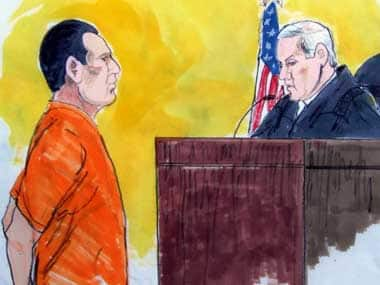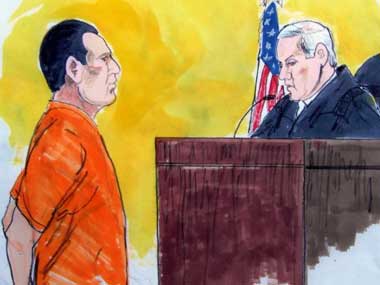New York: David Coleman Headley was sentenced on Thursday by a US court to 35 years in jail for plotting the 2008 Mumbai attacks, and, as anticipated, dodged the death sentence under a deal with the US government. US District Judge Harry Leinenweber blasted the plea bargain deal that Headley had shrewdly cut with the US government to get a lighter sentence. The judge said Headley “deserved” the death penalty, but that he only opted for the 35-year sentence after a motion by the government. “Mr Headley is a terrorist. He commits crime, cooperates and then gets rewarded for the cooperation. I don’t have any faith in Mr Headley when he says he’s a changed person and believes in the American way of life,” Leinenweber said acidly. “I do believe that it is my duty to protect the public from Mr Headley. The sentence I impose, I’m hopeful, will keep Mr Headley under lock and key for the rest of his natural life,” said Leinenweber in imposing the sentence, which was in the range of what prosecutors had requested for Headley’s cooperation. [caption id=“attachment_601760” align=“alignleft” width=“380”] AFP[/caption] Federal prosecutors in Chicago asked that Headley, 52, be sentenced to 30-35 years in prison, a merciful punishment considering Headley’s detailed reconnaissance before the Mumbai attacks. Headley’s jail term will be followed by five years of supervised release. The courtroom was charged when a victim of the Mumbai massacre testified on Thursday at the sentencing. Linda Ragsdale, a Nashville woman was shot in the back by one of the 10 Lashkar-e-Taiba gunmen who went on a rampage in India. She recalled wondering how a man as young as her son could kill innocent people. Holding back tears, Ragsdale described a barrage of bullets so intense that “waves of heat clouded” her vision. “I now know what a bullet can do to every part of the human body,” Ragsdale said. “I know the sound of life leaving a 13-year-old child. These are things I never needed to know, never needed to experience.” Ragsdale also read from a statement written by another survivor of the shooting at the Oberoi Hotel who said it would be an “appalling dishonour” if Headley was sentenced to the 30 to 35 years in prison recommended by federal prosecutors. But US Attorney Patrick Fitzgerald asked for leniency, telling the judge that Headley provided critical information which aided in the conviction of co-defendant Tahawwur Rana, as well as charges against seven other individuals. He told the judge that Headley was involved in a “very, very heinous crime” but the judge should consider the “unusual nature” of Headley’s cooperation. On the night of his arrest at O’Hare International Airport, Headley “freely admitted” his role in the Mumbai massacre within half an hour of being given his Miranda rights, Fitzgerald said. Headley’s sentencing brought up a wave of emotions for people who had lost family and loved ones in the brutal Mumbai massacre. They said a 35-year sentence was “an appalling dishonour” to those killed. “I have never really been without the feelings of loss and grief. But it does intensify it,” said soft-spoken Kia Scherr, whose husband Alan, 58, and daughter, Naomi, 13, were killed during the attacks on the Oberoi Hotel in Mumbai. They were travelling as part of the 25-member Synchronicity Foundation team exploring yoga and meditation in India. “I feel that for the magnitude of the killings that took place, David Headley has lost his right to live as a free man,” said Scherr. Scherr said her husband and daughter were having the time of their lives in India before the terrorists struck: “They loved the people, the food and the colours. My husband could have lived there — he loved it so much.” Headley’s sentencing comes in the wake of the 14-year jail term that was awarded to his associate Tahawwur Rana who was acquitted for his role in the Mumbai attack, but convicted for the conspiracy to bomb the Danish newspaper Jyllands-Posten and for aiding the Lashkar-e-Taiba. In March 2010, Headley pleaded guilty in a court hearing in Chicago to laying the groundwork for the three-day terrorist rampage in Mumbai that killed 166 people, including children. Headley said he used Rana’s immigration firm as a cover during five different trips to Mumbai to prepare for the attack. Headley stalked India from 2006 to 2008, performing critical surveillance of numerous targets, including the Taj Mahal and Oberoi hotels, as well as the Chabad House, Leopold Café, and the main rail station in Mumbai, all of which were attacked resulting in massive civilian casualties. US attorney Gary S Shapiro said in a 20-page position paper on Tuesday that the US had ruled out any extradition for Headley, because he had provided information to US agencies about terror outfits. The deal spares Headley from extradition to India, Pakistan or Denmark. The Washington-born son of a former Pakistani diplomat and American woman, Headley’s Western appearance and US passport helped him slip under the radar for much of the seven years that he spent working with Islamic militant groups. He was born Daood Gilani but changed his name to David Coleman Headley in 2006 “to present himself in India as an American who was neither Muslim nor Pakistani,” prosecutors said. Headley’s different coloured eyes (one green, the other blue) are a fitting symbol of the double-agent role he has played for years. He worked as an operative for Pakistani extremists and as an American FBI informant and government witness. Cutting a plea bargain is not new to Headley. In 1997, Headley was charged in Brooklyn with importing heroin into the US. He provided so much information about his Pakistani suppliers that he received a mere 15-month sentence in jail for cooperating with the US Drug Enforcement Agency.
AFP[/caption] Federal prosecutors in Chicago asked that Headley, 52, be sentenced to 30-35 years in prison, a merciful punishment considering Headley’s detailed reconnaissance before the Mumbai attacks. Headley’s jail term will be followed by five years of supervised release. The courtroom was charged when a victim of the Mumbai massacre testified on Thursday at the sentencing. Linda Ragsdale, a Nashville woman was shot in the back by one of the 10 Lashkar-e-Taiba gunmen who went on a rampage in India. She recalled wondering how a man as young as her son could kill innocent people. Holding back tears, Ragsdale described a barrage of bullets so intense that “waves of heat clouded” her vision. “I now know what a bullet can do to every part of the human body,” Ragsdale said. “I know the sound of life leaving a 13-year-old child. These are things I never needed to know, never needed to experience.” Ragsdale also read from a statement written by another survivor of the shooting at the Oberoi Hotel who said it would be an “appalling dishonour” if Headley was sentenced to the 30 to 35 years in prison recommended by federal prosecutors. But US Attorney Patrick Fitzgerald asked for leniency, telling the judge that Headley provided critical information which aided in the conviction of co-defendant Tahawwur Rana, as well as charges against seven other individuals. He told the judge that Headley was involved in a “very, very heinous crime” but the judge should consider the “unusual nature” of Headley’s cooperation. On the night of his arrest at O’Hare International Airport, Headley “freely admitted” his role in the Mumbai massacre within half an hour of being given his Miranda rights, Fitzgerald said. Headley’s sentencing brought up a wave of emotions for people who had lost family and loved ones in the brutal Mumbai massacre. They said a 35-year sentence was “an appalling dishonour” to those killed. “I have never really been without the feelings of loss and grief. But it does intensify it,” said soft-spoken Kia Scherr, whose husband Alan, 58, and daughter, Naomi, 13, were killed during the attacks on the Oberoi Hotel in Mumbai. They were travelling as part of the 25-member Synchronicity Foundation team exploring yoga and meditation in India. “I feel that for the magnitude of the killings that took place, David Headley has lost his right to live as a free man,” said Scherr. Scherr said her husband and daughter were having the time of their lives in India before the terrorists struck: “They loved the people, the food and the colours. My husband could have lived there — he loved it so much.” Headley’s sentencing comes in the wake of the 14-year jail term that was awarded to his associate Tahawwur Rana who was acquitted for his role in the Mumbai attack, but convicted for the conspiracy to bomb the Danish newspaper Jyllands-Posten and for aiding the Lashkar-e-Taiba. In March 2010, Headley pleaded guilty in a court hearing in Chicago to laying the groundwork for the three-day terrorist rampage in Mumbai that killed 166 people, including children. Headley said he used Rana’s immigration firm as a cover during five different trips to Mumbai to prepare for the attack. Headley stalked India from 2006 to 2008, performing critical surveillance of numerous targets, including the Taj Mahal and Oberoi hotels, as well as the Chabad House, Leopold Café, and the main rail station in Mumbai, all of which were attacked resulting in massive civilian casualties. US attorney Gary S Shapiro said in a 20-page position paper on Tuesday that the US had ruled out any extradition for Headley, because he had provided information to US agencies about terror outfits. The deal spares Headley from extradition to India, Pakistan or Denmark. The Washington-born son of a former Pakistani diplomat and American woman, Headley’s Western appearance and US passport helped him slip under the radar for much of the seven years that he spent working with Islamic militant groups. He was born Daood Gilani but changed his name to David Coleman Headley in 2006 “to present himself in India as an American who was neither Muslim nor Pakistani,” prosecutors said. Headley’s different coloured eyes (one green, the other blue) are a fitting symbol of the double-agent role he has played for years. He worked as an operative for Pakistani extremists and as an American FBI informant and government witness. Cutting a plea bargain is not new to Headley. In 1997, Headley was charged in Brooklyn with importing heroin into the US. He provided so much information about his Pakistani suppliers that he received a mere 15-month sentence in jail for cooperating with the US Drug Enforcement Agency.
Headley dodges death, gets 35 years in US jail for 26/11 terror
Uttara Choudhury
• January 25, 2013, 10:22:38 IST
In a charged Chicago courtroom, a US judge says Headley deserved to die, and criticises the ‘plea bargain’ with the US government that let Headley walk away with a relatively light sentence.
Advertisement
)
End of Article